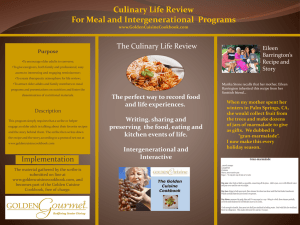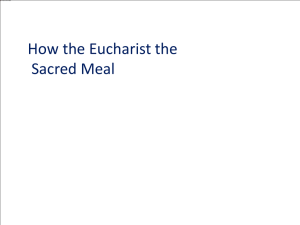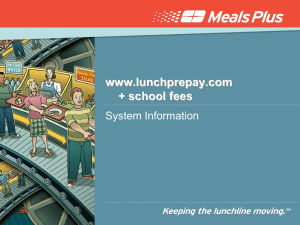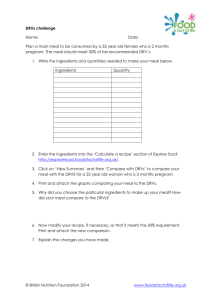Word Format - WACE 2015 2016
advertisement
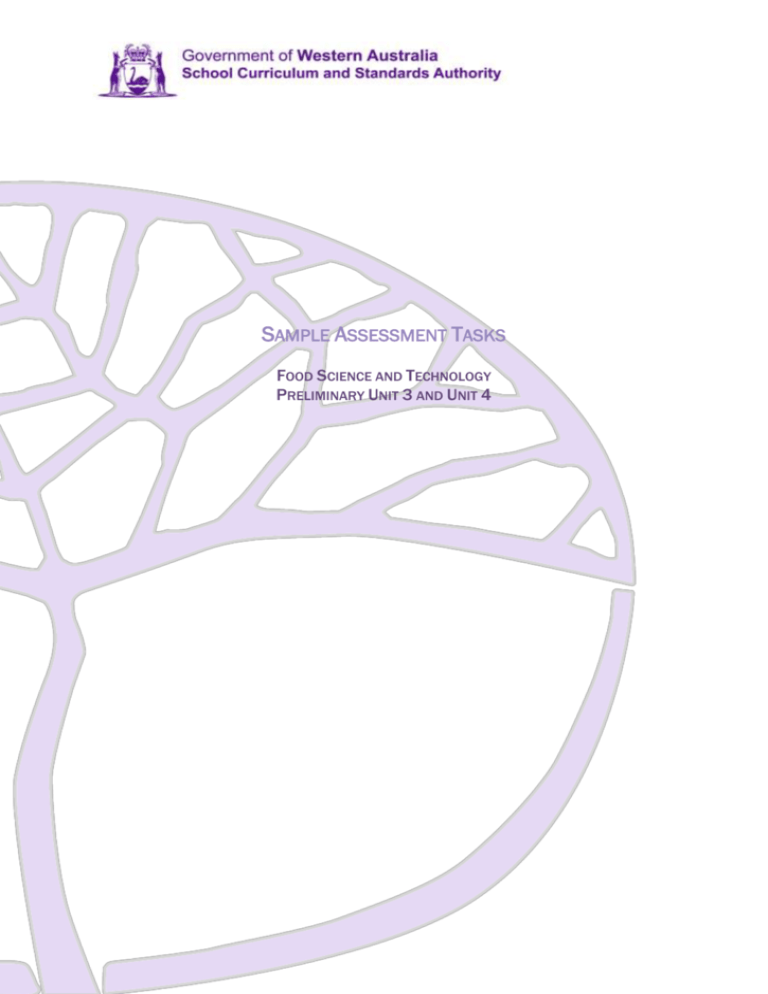
SAMPLE ASSESSMENT TASKS FOOD SCIENCE AND TECHNOLOGY PRELIMINARY UNIT 3 AND UNIT 4 Copyright © School Curriculum and Standards Authority, 2015 This document – apart from any third party copyright material contained in it – may be freely copied, or communicated on an intranet, for non-commercial purposes in educational institutions, provided that the School Curriculum and Standards Authority is acknowledged as the copyright owner, and that the Authority’s moral rights are not infringed. Copying or communication for any other purpose can be done only within the terms of the Copyright Act 1968 or with prior written permission of the School Curriculum and Standards Authority. Copying or communication of any third party copyright material can be done only within the terms of the Copyright Act 1968 or with permission of the copyright owners. Any content in this document that has been derived from the Australian Curriculum may be used under the terms of the Creative Commons Attribution-NonCommercial 3.0 Australia licence Disclaimer Any resources such as texts, websites and so on that may be referred to in this document are provided as examples of resources that teachers can use to support their learning programs. Their inclusion does not imply that they are mandatory or that they are the only resources relevant to the course. 2014/32451v5 1 Sample assessment task Food Science and Technology – Preliminary Task 2 — Unit 3 Conditions Period for completion of the task: three weeks __________________________________________________________________________________ Two-course meal Students will: recognise the nature and operation of simple food-related systems produce food products, services or systems. For this task: Working individually, students plan, prepare and serve a simple two-course meal and use simple food presentation skills. The dishes should be carefully planned to complement each other and be served at their optimum temperature. Students will continue to implement kitchen practices, such as an organised work area, collect and accurately measure ingredients, safely handle raw ingredients and appropriate clean-up procedures. In preparing the meal, students will use the stove-top/hot plates and grill confidently and safely. When planning the two-course meal, students could consider one or more of the following constraints: the nutrient value of the ingredients use of a variety of foods to vary the flavour, colour, texture and cooking methods food preferences, allergies and cultural beliefs incorporation of seasonal foods is it a special occasion such as a birthday? how long will it take to prepare and cook the meal? the approximate cost of the food or can leftover food be incorporated. Students, with assistance if required, develop a plan for a simple two-course meal, considering one or more of the constraints listed above. A simple two-course meal could be: Mexican Beef Quesadilla One or half flour/corn tortilla filled with a savoury minced beef mixture – cook in a pan on the stove top – grate cheese and slice or grate vegetables such as capsicum, carrot, fold tortilla to form half-moon shape, heat on the stove top in a hot frypan, cut into triangles and serve. S’mores A plain, sweet biscuit or banana as a base, deck with sliced fruit such as strawberry then chopped chocolate and top with a marshmallow, grill to heat and toast. Sample assessment tasks | Food Science and Technology | Preliminary Unit 3 and Unit 4 2 Brainstorm food presentation ideas for serving the two-course meal. Incorporate simple sketches and consider these four components: appearance colour garnish temperature. Before students commence preparations for their two-course meal, teacher to identify aspects of personal safety for using cooking appliances and demonstrate correct procedures, including the safe ignition of gas appliances, and the use and dismantling of the grill for cleaning. Students should practise and demonstrate confident, safe use of the cooking appliances required to prepare their meal. Undertake a review of safety procedures in the use of the stove-top/hot plates. Students compile a list of things to remember when cooking on hot surfaces associated with the use of the stove-top/hot plates. The list can be compiled in a variety of ways, including: written/orally identification of appropriate safety features from a pre-prepared list, or annotating a diagram of a stove-top/hot plate. Compile a shopping list of all the ingredients required to make the proposed two-course meal. From the selected recipes, students itemise each food and the quantity required. Identify and list foods that may not be included in the ingredients list, such as oil and garnishes. Categorise the food items as required on the school food order template. Review the method for preparing each recipe. Students identify production tasks required for each recipe, such as grating, chopping, mixing, heating, and select the appropriate preparation equipment required to complete each different production task. Check that all the equipment required is available and that students are familiar with it and its safe use. Each of the two selected recipes will have a method explaining how to make the dish. Students combine the two methods to develop a step-by-step production plan to systematically produce the two-course meal. The following kitchen practices should be implemented into the production plan: setting out preparation equipment for an organised work area collection and accurate measurement of ingredients safe handling of raw ingredients appropriate clean-up procedures serving time. Students serve the two-course meal using simple food presentation skills. The meal should be served on time and be at the optimum temperature. Other constraints, such as food preferences, may have also been incorporated into the meal. Sample assessment tasks | Food Science and Technology | Preliminary Unit 3 and Unit 4 3 Your progress in this task will be documented in the following ways: brainstorming worksheet on food presentation ideas for your two-course meal your plan for a two-course meal and shopping list teacher notes on how you safely ignite, use and clean the grill list of the things you need to remember for safely using the stove-top/hot plates photograph of preparation equipment you have selected for different tasks your step-by-step production plan of how to produce your two-course meal teacher observation notes of your two-course meal served using simple food presentation skills. Sample assessment tasks | Food Science and Technology | Preliminary Unit 3 and Unit 4 4 Completion checklist – Task 2 Two-course meal Unit outcome: Recognise the nature and operation of simple food-related systems; Produce food products, services or systems Description of evidence to be collected by teacher Date evidence collected Level of support comments Brainstorming worksheet on food presentation ideas for your two-course meal Your plan for a two-course meal and shopping list Teacher notes on how you safely ignite, use and clean the grill List of the things you need to remember for safely using the stove-top/hot plates Photograph of preparation equipment you have selected for different tasks Your step-by-step production plan of how to produce your two-course meal Teacher observation notes of your two-course meal served using simple food presentation skills Sample assessment tasks | Food Science and Technology | Preliminary Unit 3 and Unit 4 5 Sample assessment task Food Science and Technology – Preliminary Task 6 — Unit 4 Conditions Suggested period for completion of the task: three weeks ___________________________________________________________________________ Food for the fete Students will: organise, implement and manage production processes in food‐related environments produce food products, services or systems. Background scenario for the task: To raise funds, the annual school Fun and Food Fete is scheduled for mid-Semester 2. Your Food Science and Technology class has decided to work together and operate a food stall. In keeping with the school’s healthy food policy, stallholders are required to sell healthy food products only. Investigate factors to consider when planning for the food stall and selecting the food to sell. planning factors to consider could include: where the fete will be located what time of the day number of people predicted to attend weather facilities provided at the stall (e.g. freezer, refrigerator, cleaning) transportation of food, keeping food safe areas of potential cross contamination safe temperature zone during production, transportation and on site production processes (assembly line or batch processing, and food service system) allocation of tasks, roles and responsibilities dependent on individual skill. factors to consider when selecting food to sell could include: nutritive value – based on the Healthy Eating Pyramid (Nutrition Australia May 2015) and school policy appearance (presentation), colour, flavour seasonal foods processing requirements portion control/serving size storage of raw and/or cooked foods packaging qualities cost/profit per serve. Sample assessment tasks | Food Science and Technology | Preliminary Unit 3 and Unit 4 6 Brainstorm possible food ideas for the stall. Ideas should be based on the Healthy Eating Pyramid (Nutrition Australia May 2015) food selection model and comply with the school’s healthy food policy. From the brainstorm of ideas and the identified factors outlined above, the class could consider food stalls such as Super Smoothies (e.g. hot or cold milk drinks, or fruit/vegetable-based drinks), The Health Bar (e.g. fruit salad cups, muesli slices or banana/zucchini bread), and The Curry Bowl (e.g. precooked chicken, beef, vegetable curries, heated and served on the day) as possibilities. Individual student skills and class co-operation will impact on the decision. As a class, consider the planning and food selection factors already identified, and make a decision on the preferred type of food stall for the fete. Identify two possible food ideas for the stall. Find a suitable recipe for each of the two identified ideas. Work as a class to trial each recipe. Individually complete the ‘recipe review sheet’ at the conclusion of the trial. Use one or two words to describe the food appearance (presentation), colour, flavour and serving size. On the recipe review sheet, make two suggestions on how to improve the nutritive value of the recipe and/or its presentation. Contribute this information to the class discussion and decide on the best recipe to prepare for the food stall. For the selected recipe, sketch a suggested method of packaging the food for sale at the fete. Annotate the sketch, identifying features of the packaging, material used and food safety. Suggest the best place to package the food for sale; for example, packaging a smoothie may be best at the point of sale whereas a curry may be individually packed in the classroom, frozen and reheated on the day of the fete. Establishing and managing efficient food production processes can produce large quantities of food quickly and safely. An assembly line production system is an efficient way to produce large quantities of food. This production system can occur well before the event with the food being stored (e.g. frozen) ready for the day of the fete or a production system can be developed at the point of sale. To prepare food for the fete, all class members will need to confidently work together in the kitchen and accurately follow recipe instructions. As a class, break down the preparation instructions for the selected recipe and highlight the major processing tasks. Develop a step-by-step flow chart for the assembly line production of the recipe and include suggested tasks/roles and responsibilities for all class members. Label each step. To reaffirm roles and responsibilities in the assembly line, all students are to briefly describe and/or discuss their allocated role and responsibility with their teacher and/or assistant. Highlight aspects of personal safety, such as protective footwear, working in confined areas, including knife safety, and confidence in using the kitchen/food stall equipment. Also, the teacher will observe these aspects of personal safety during the assembly line production process. Your progress in this task will be documented in the following ways: brainstorming worksheet on healthy food choices, based on a the Healthy Eating Pyramid (Nutrition Australia May 2015) food model, suitable for the school fete recipe review sheet of your suggestions of how to improve the nutritive value and/or the appearance (presentation) of the selected recipe annotated sketch of your suggestions of how to package the food for sale, including features such as material used and food safety Sample assessment tasks | Food Science and Technology | Preliminary Unit 3 and Unit 4 7 your step-by-step flow chart of the assembly line production, including who is allocated to specific tasks teacher notes of: assembly line role/responsibility personal safety when working in confined areas and confidence in using kitchen equipment. Sample assessment tasks | Food Science and Technology | Preliminary Unit 3 and Unit 4 8 Completion checklist – Task 6 Food for the fete Unit outcomes: Organise, implement and manage production processes in food related environments; Produce food products, services or systems Description of evidence to be collected by teacher Date evidence collected Level of support comments Brainstorming worksheet on healthy food choices, based on a the Healthy Eating Pyramid food model, suitable for the school fete Recipe review sheet of your suggestions on how to improve the nutritive value and/or the appearance (presentation) of the selected recipe Annotated sketch of your suggestions of how to package the food for sale, including features such as material used and food safety Your step-by-step flow chart for assembly line production, including who is allocated to specific tasks Teacher notes of: assembly line role/responsibility personal safety when working in confined areas, and confidence in using kitchen equipment Sample assessment tasks | Food Science and Technology | Preliminary Unit 3 and Unit 4

